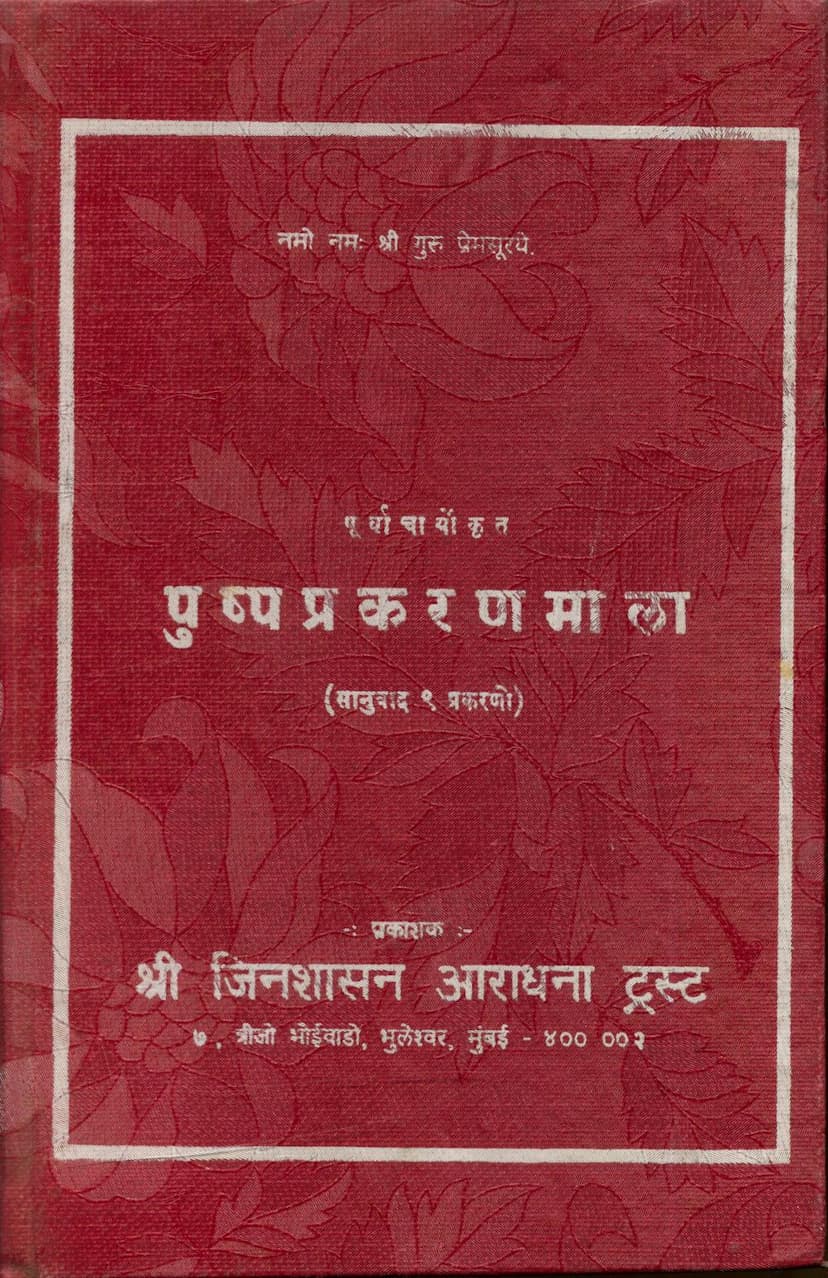Pushpa Prakaran Mala
Added to library: September 2, 2025

Summary
Here's a comprehensive summary of the Jain text "Pushpa Prakaran Mala" based on the provided catalog link and the extracted text:
Book Title: Pushpa Prakaran Mala (पुष्प प्रकरण माला) Author: Purvacharya (पूर्वाचार्योंकृत) Publisher: Jinshasan Aradhana Trust (श्री जिनशासन आराधना ट्रस्ट) Catalog Link: https://jainqq.org/explore/023119/1
Overall Summary:
"Pushpa Prakaran Mala" is a significant Jain text compiled by ancient Acharyas and published by the Jinshasan Aradhana Trust. As indicated by the title and the content, it appears to be a collection of nine distinct works (प्रकरण) that are thematically related, likely to the spiritual journey and the underlying principles of Jainism, possibly using the metaphor of flowers (Pushpa) to represent different stages or aspects of spiritual knowledge. The text aims to revive and present rare scriptural gems, making them accessible to both scholars and religious devotees.
Key Components and Content:
The "Pushpa Prakaran Mala" is comprised of nine "Prakaranas" (chapters or treatises), each authored by different Purvacharyas. These Prakaranas cover a wide range of essential Jain philosophical and practical topics, including:
-
Kaya Sthiti Prakaran (कायस्थिती प्रकरण): This treatise, attributed to Acharya Kulmandan Suri, discusses the concept of "Kaya Sthiti," which refers to the cycle of rebirth and the states of existence. It details the life spans and movements of beings across the fourteen Rajlokas (realms) and the four Gatis (states of existence). The text explains the concept of returning to the same life-span or realm after death. It also touches upon the detailed analysis of life-forms, their senses, and their bodies as described in scriptures like the Prajnapana Sutra.
-
Vichar Saptatika (विचार सप्ततिका): Authored by Vinaykushal, this work is a collection of twelve important concepts or "Vichars." It covers topics such as the nature of eternal statues (Shaashvati Pratima), celestial temples (Chetya), Shilas (rocks), the diffusion of sunrays, Krishna Raji (a specific concept related to realms or cycles), and the fourteen stages of spiritual progress (Guna Sthana).
-
Vichar Pashika (विचार पाशिका): This work, by Vanaramuni, a disciple of Anandvimal Suri, delves into nine "Vichars." Key subjects include the duration of gestation, the states of human existence, the path of beings, their sufficiency (Paryapti), and other critical considerations.
-
Sarmukta Vichar Garbhit Mahavir Stavan (सर्माकप्रचार गर्भित महावीर स्तवन): Attributed to Nyayasagar Suri, this is a hymn dedicated to Lord Mahavir. It beautifully and concisely explains the nature of Samyak Tattva (right understanding or faith), its various types, and its influencing factors.
-
Siddha Pashika (सिद्धपाशिका): This treatise, by Devendra Suri, references the text "Siddha Prabhoo" and expounds upon fifteen "Karanas" (means or methods). It describes the pure essence of the Siddha Permatma (liberated souls) who are free from all karmas, offering a profound yet clear description of their all-pervading nature.
-
Siddha Dandika (सिद्ध दण्डिका): Also by Devendra Suri, this work, as evidenced by the text provided, is a detailed exploration of the spiritual journey and the "dandikas" (stages or lines of progression) of achieving Siddhahood. It highlights how countless kings, through their sincere internal spiritual practice, attained the state of Siddhi and ascended to the Vimana (celestial abodes). The text seems to follow a chronological or logical sequence of karma progression.
-
Nigoda Shatrisika (निगोद षट्रिशिका): This Prakarana beautifully clarifies the concepts related to Nigoda, a basic state of existence in Jainism. It explains the types of beings in Nigoda, their classifications, the structure of their bodies (Golam), the condition of beings within those bodies, their lifespan, and their significance.
-
Shri Bhava Prakaran (श्री भावप्रकरण): Authored by Vijayavimal Suri, this work elaborates on the concept of "Bhava" (state or mode of existence). It discusses Dharma, Adharma, Akashastikaya, Kala, Skandha, Karma, Gati (motion), and Jiva (soul) as eight fundamental principles. It then intricately explains the five "Bhavas" (states of being), their various classifications (Bhangama), differences, stages of spiritual development (Guna Sthana), and how these states manifest in the cycle of existence.
-
Shri Panchan Granthi (श्री पञ्चनग्रंथी): This treatise is a summary or "Sangrahani" of the twenty-fifth Shataka (chapter) of the Bhagvati Sutra. It meticulously examines the five types of mendicants (Sadhu) – Pulak, Bakush, Kushil, Nirgrantha, and Acharya – detailing their definitions, characteristics, methods of attainment, classifications, and various rituals, making it a detailed and foundational work.
Publisher and Context:
The Jinshasan Aradhana Trust, the publisher, is dedicated to reviving and publishing ancient Jain scriptures. The text mentions that this particular edition was made possible through financial contributions, highlighting the collective effort in preserving and disseminating this knowledge. The publication also notes that the trust has been instrumental in bringing back to life around 60 such texts, with a strong intention to revitalize hundreds more.
Significance and Target Audience:
The "Pushpa Prakaran Mala" is presented as a rich source of profound scriptural secrets, making it highly valuable for scholars and philosophy enthusiasts. Its translation and commentary make it accessible to those who may not be fluent in Sanskrit or Prakrit, thereby broadening its reach to all dharma-loving individuals. The text is considered a treasure trove of Jain wisdom, originally compiled by esteemed Purvacharyas.
Overall Purpose:
The primary aim of this compilation and publication is to make these rare and ancient Jain treatises available to a wider audience, fostering a deeper understanding of Jain philosophy, cosmology, ethics, and spiritual practices. It serves as a testament to the enduring legacy of Jain scriptures and the dedication of institutions like the Jinshasan Aradhana Trust in preserving this valuable heritage.